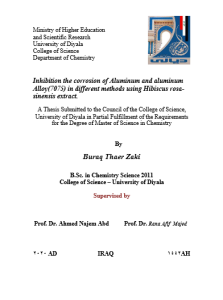Abstract
In general, pile foundations of different cross-sectional area and group configurations are typically employed to support the structural and external loads such as cyclic loads. This cyclic load may transmit laterally or/and vertically to the foundation as centric load, and sometime be eccentric loads.
Therefore, this research is aimed to study the effect of two cross-sectional shape of pile (circular and square), three pile group configurations (square, triangular and rectangular) and three pile spacings )3D, 5D and 7D( (D is the pile diameter) on the pile group behavior under combined loading. To achieve this aim, a laboratory small scale model has been developed and mainly included soil tank and lateral cyclic load apparatus, in addition all tools and materials used for completing the tests. The soil used in this study is sandy soil with a relative density of 70%.
The combined load is one-way lateral cyclic load simultaneously with vertical static load. The axial load is calculated from allowable load capacity for each group (150, 200, 250 N). The frequency of cyclic load was 0.2 Hz and continue to 100 cycles with critical load ratio of 100% from ultimate lateral load. The axial load applied in the center of pile cap. While, the lateral cyclic load act at three points (at the center of pile cap, at 0.25S and 0.5S eccentric distance), where S is spacing between piles.
It can be concluded that in general, the pile cross sectional shape had significant effect on the lateral performance of pile group. Where the groups with pile of square section have lateral displacement less than circular by about 30% in all cyclic load magnitude. As well as, the group configurations and piles spacings also affected the lateral group performance. For all configuration, the spacing of 7D provide larger effect on the lateral resistance. In this case, for groups of (square, triangular and rectangular arrangement), the lateral displacement reduced to (26%, 42% and 44%) compared to 3D spacing.
It can be seems that when cyclic load applied in an eccentric distance lead to reduce the lateral resistance, especially for piles of close spacings. The increase in the lateral displacement for the maximum eccentric distance reach to 54% and 45% for circular and square pile sections respectively. Additionally, the pile groups twisted with different angles which increase noticeably with increasing of load eccentricity to about 75%, that’s means the pile failed laterally when applied this type of loading.
For the axial displacement, the vertical movement for all pile group models was upward, which was in case of using square pile shape more than using circular shape by 20%. The vertical movement when applied load at 0.5S was about 0.46 and 0.55 from the embedded length of the pile for circular and square pile shape, respectively.
Finally, the maximum bending moment also effected by the point of eccentricity, it increases to 75% at the maximum eccentric distance. As well as, it effected by the pile section, where the square pile section shows bending moment less than that of circular section by about 50%. It also effected by the arrangement and spacings of pile group. The group of four piles has the lowest bending moment, as well as, the spacing of 3D had largest bending moment than 5D and 7D by about 49%. The maximum bending moment occurred at depth of the first quarter of the embedded length of the pile, from the top of soil.





